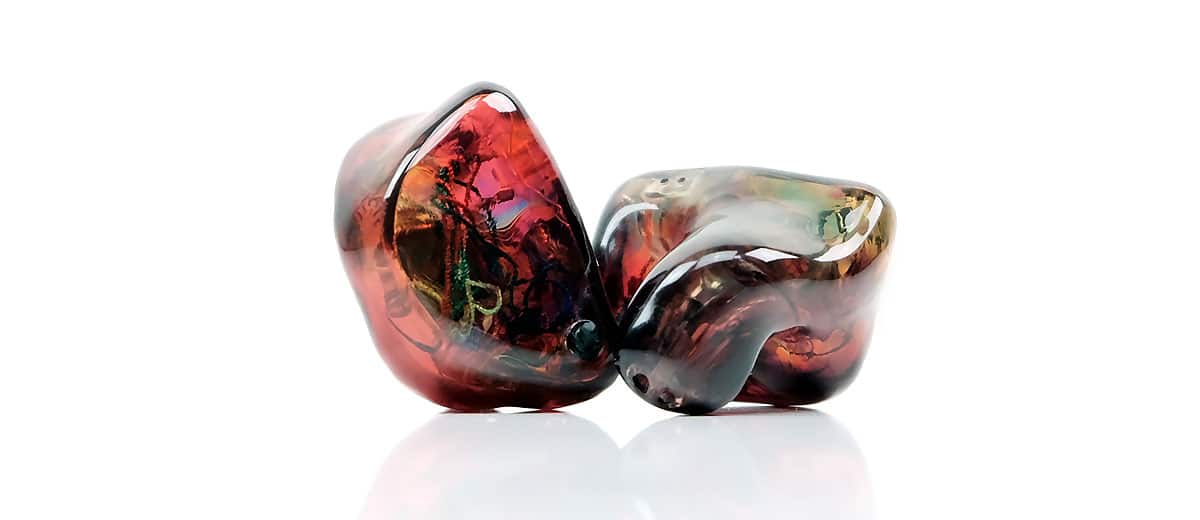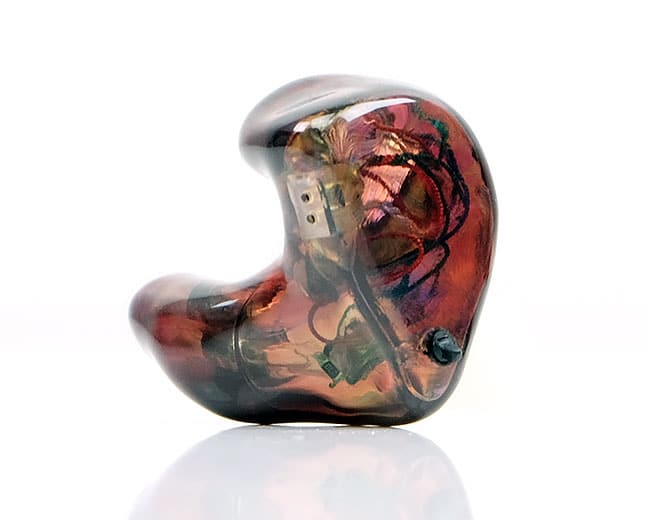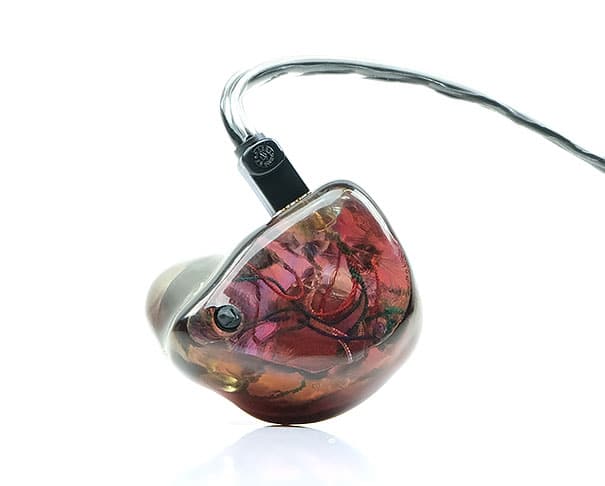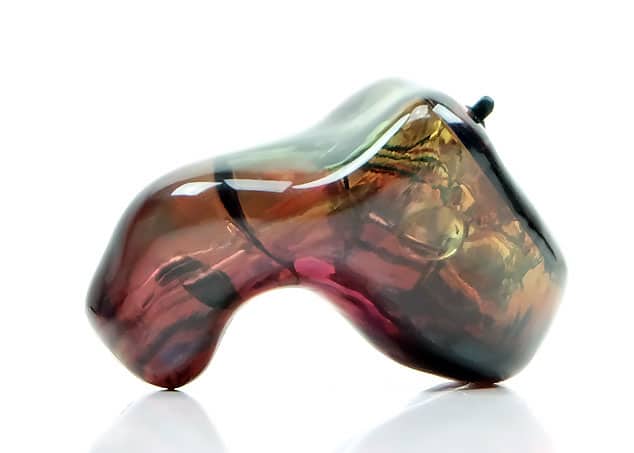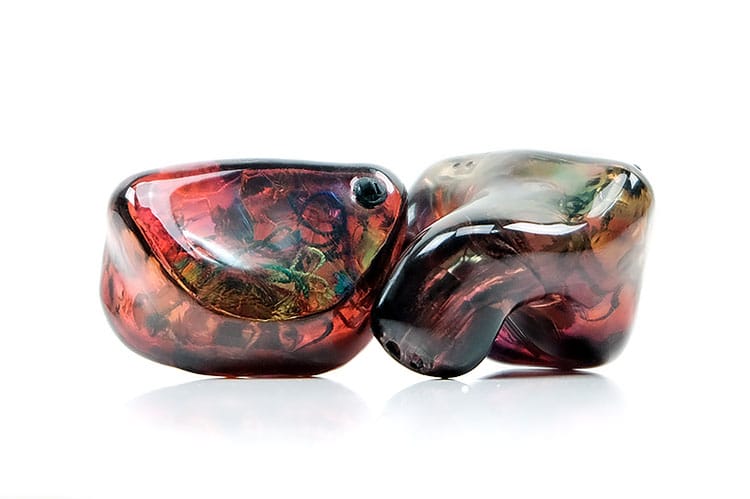Meet the Lime Ears psi
Design
Ever year Lime Ears up their game when it comes to quality custom designs. Last year we tried their Scarabeus speckled reflective green and blue on the Aether R and this year it is the complex Cosmic Swirl on the psi.
You can find the Cosmic Swirl option under the Premium design option on their design tool online and costs an additional €40 which is not that expensive of an option. The finishing on these are perfect by the way with no bubbles or blips to be seen anywhere. The only break in the flow of the visual are the small switches at the bottom of the faceplate that control the bass performance.
This design is a foundation of translucent reds and pinks with a studied splash of orange, yellow, green, and blue. I am presuming the way everything comes together that each swirl design is entirely unique also.
I thought the overall effect came out rather well on initial impressions and does add some beautiful reflective visuals on the internal wiring and drivers which are fairly easy to make out given the shell is translucent.
Finishing
Buttery smooth finish and bubble-free as you would expect in terms of finishing, however, what it did notice is the little change under lighting. Under indoor conditions, the finish has a darker look but when you shine the light on it then it has more brilliance in the shine. I suspect that is the translucent shell allowing natural sunlight to exaggerate the visual aesthetic.
Lime Ears have also gone for a wide nozzle ‘nub’ and a flat dual-bore finish so this is not a Vari Bore design since the two bores are of equal size. The bass switch to the base of the faceplate on each side is also very easy to adjust and not too close to the surface. The sockets are 2-pin 0.78mm and sit flush to the outer shell in an over-the-ear configuration for cable use.
Stock Cable
Given the price point, I am not surprised the psi comes packed with a Plastics One detachable 1m 4-wire copper cable. ‘It will do for now’ is the phrase I tend to use for these cables.
Not that the Plastics One variant cable is without any benefit. They always retain a wonderfully light and easy memory-free handling quality to them. The strain relief is excellent, the pin diameters are usually consistent and easy to insert and they tend to be microphonic free. There is no exception to that description with the psi version either so those are the pluses.
The negatives are usually in terms of higher than normal resistance leading to a lack of dynamic range and absolute clarity across the FR.
Options
There are better aftermarket versions on the market for less than $100 that will give a lift to the performance of the psi such as the $99 Effect Audio’s Maestro or just above $100 with PW Audio’s No 10.
Of those two the $99 Maestro is the more appropriate cable pairing. It does an excellent job upping the dynamic range from the stock cable and injecting some air between instrumental notes. The low-end has a lot more definition but sounds firmer and more physical rather than the tock cable softness.
The PW Audio No.10 is more neutral for me but teases out a bit more treble energy from the psi than the stock and has better staging width also.
Comfort & Isolation
Oh blimey, the isolation on the psi is top-notch. Being an all balanced armature design there is no venting required so zero holes in the shell for noise to leak in or out. That means noise attenuation right across the board. ‘Air cons go mute’ is the phrase I would like to coin for how well these block out noise.
Of course, how good they are for a fitting depends on the quality of the ear impressions you send to Lime Ears as they do not handle digital STL files. In my case I have been using an old one they have on file for me for a few years but my ears still seem to be the same size and shape as the comfort levels are excellent.
One thing to further note since the initial impression is the pressure balance on the psi. That is the balance between how accurate and deep the fitting is and how much pressure is applied to the ear canal to compensate for any chance of a gap in the seal. This particular psi has nailed it for me in the same way the FIBAE 7 from Custom Art nailed it with zero discomfort.
Lime Ears psi Sound Impressions
Bass Off
The core sound signature of the psi with the bass switch off is smooth, sweet-sounding with more than a hint of warmth and volume on the low-end but balanced really nicely with some good treble contrast.
The low-end is not so aggressive to dominate or overpower, at least with the bass switch off and the treble not so brittle to sound harsh. It has just enough lower-treble forwardness around 5-6k to prevent notes sounding dull or too rounded.
I would not call this v-shaped, however. Overall, the timbre has a SET amp type quality when compared to similar 3 driver BA configurations like the Gaudio Clariden which is cooler tone and with more bass/treble contrast. This is more of a languid or polite analog-type delivery with a bit more bloom and decay slipping in making it fairly forgiving than analytical sounding in nature.
There is a small lift for vocal presence with some additional clarity and air in the voicing from the treble extension which is actually quite good for a triple driver. Sometimes, like the Avara AV3, there is a tendency to focus on the mids and gently roll off the top and bottom but that does not seem to be the case here. Vocals are strong, clean, and clear on the psi and percussion has a lovely shimmery overtone without sounding splashy.
Bass On
With the bass switch turned on the presentation is going to be more polarizing because the low-end is quite lifted, further forward, and more powerful sounding. I suspect there is something like an 8dB rise from 20Hz up to around the first crossover in the upper bass and 1-2dB more through the mids.
Timbre becomes a bit warmer and richer with the bass switch on and you get less of a contrast between it and the treble compared to keeping the switch off. Percussion has more presence with the switch off and instrumental separation is enhanced. Imaging cues should also be a bit easier to pick out with the bass switch turned off.
Now whilst vocals seem to get a lift with more body in keeping with Lime Ear’s adherence to the Fletcher-Munson principle the treble does diminish a little in terms of presence.
The switch does not pull back the treble but the amplification on the lower region is greater than higher up so even-harmonic overtones are pushed more to the fore. Not enough for it to sound dull or suffering in a lack of air but rather your attention is drawn much more to the bass and vocal presence.
There is less room for anything nuanced to makes its presence felt in between as a result. That is not an issue for modern pop, EDM, and R’n’B that tend to focus on those two areas for maximum effect. Especially modern R’n’B that tends to have spare arrangements and clear separation of bass, vocal, and percussion and a lot of open space in between.
Preferences
From the original First Contact, I was all set to declare the bass switched 2 on profile as the winner but after a few more weeks of testing and comparing I have to say my preference now sits squarely with keeping the bass switch off.
That is not to say the bass switch on is not fun, it is, but in a messy colored manner for casual listening rather than anything deeper. I call it the bonus option akin to opening up the back of a mini and finding the previous owner left the 15″ sub wired up and ready to roll.
Again, with a small investment in a good aftermarket cable, you can enhance what I would call a slightly soft-sounding stock cable performance. The Psi can scale with a lower-resistance cable and though it is still a fairly BA timbre it does sound more immersive and physical with the EA Maestro.
Click on Page 3 below for Synergy & Comparisons

